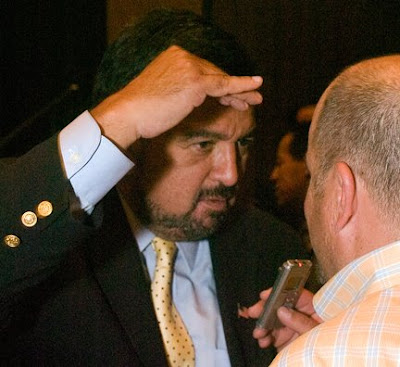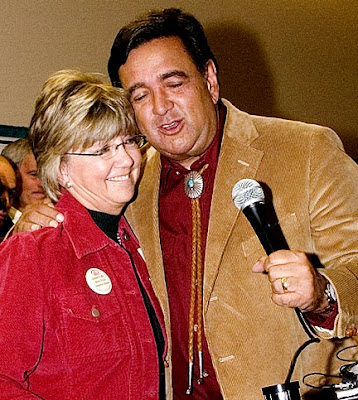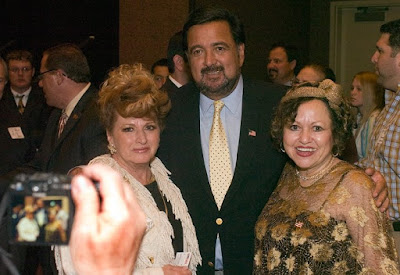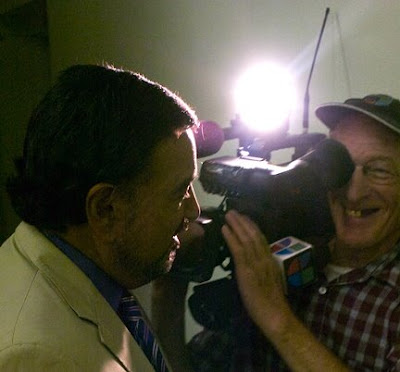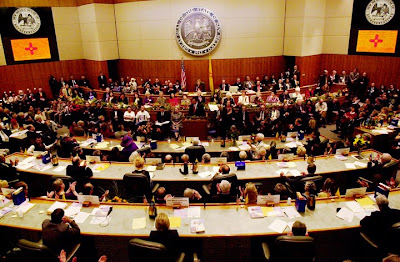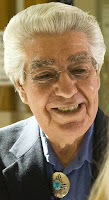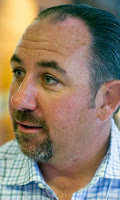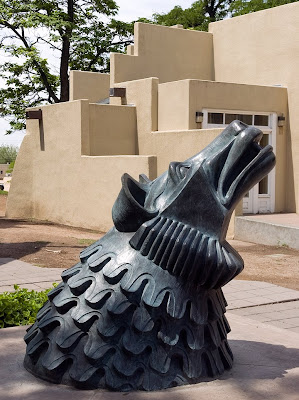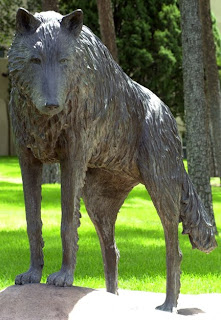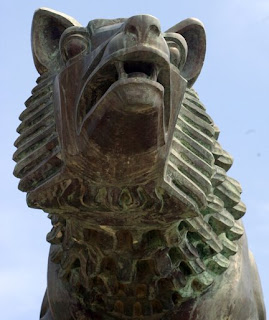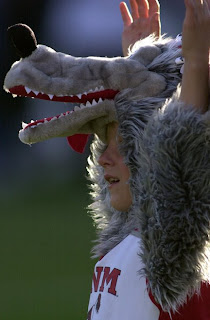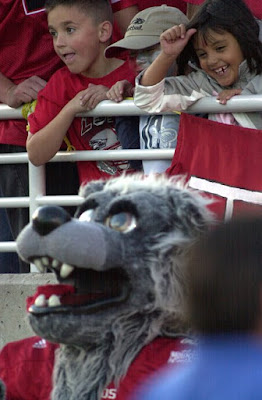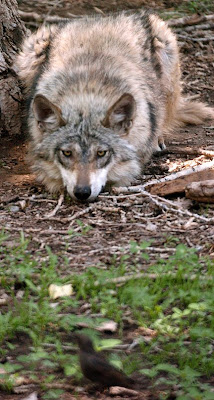Ed Pennybacker, former local radio and television news reporter died this past week after a long illness. He was 80.
He was the news reporter for KQEO AM radio and KGGM TV, which is now KRQE in the 1960s. Pennybacker then became a consumer watchdog with his “On Your Behalf” segments on KOAT TV in the late 1970s and 80s.
 This picture was taken at KOAT in Oct. 1978, as he prepared for one of his consumer reports. He was working with new technology; next to the electric typewriter is a 3/4 U-Matic Video tape cassette that was just starting to replace sound to film.
This picture was taken at KOAT in Oct. 1978, as he prepared for one of his consumer reports. He was working with new technology; next to the electric typewriter is a 3/4 U-Matic Video tape cassette that was just starting to replace sound to film.However, Pennybacker is best remembered amongst journalists and those now old enough to have remembered growing up in the 1960s, attending high school and listening to what was then considered Albuquerque’s premier day-time rock and roll radio station, KQEO, as the ultimate mobile newscaster. He covered the news in town back in the day when KQEO would go off the air every evening at sunset with the playing of the National Anthem. Kids who wanted to continue to listen to rock and roll would switch over to powerful, 50,000 watt KOMA 1520 out of Oklahoma City.
Those were the days of commercial AM radio; FM was not something you tended to find in automobile radios, it was reserved for non-commercial “classical music” listeners. It was also a time when radio stations broadcast under the old Federal Communications Commission license rules, which included requirements to provide news, public service and entertainment that, according to the Federal Communications Act, “will serve the public interest, convenience, and necessity.” Unlike today, you got local news coverage by law.
Pennybacker was a glorified ambulance chaser. Don’t get me wrong; he was one of those quintessential newsmen. He could present a story condensed to 20-seconds; a headline and two sentences and you were informed. However, his specialty was fatal automobile accidents.
Pennybacker’s moniker was “Big Red.” He was a barrel-chested man with a stern commentators voice who played a gruff character; serious about his profession. However, when off the air he was also easy going and had a quick smile. At KQEO, he drove an Oldsmobile 442, fully equipped under the hood and loaded with radios and emergency police and fire scanners. It had enough whip antennas mounted on the back of his car to possibly be confused with a tuna trawler. Of course it was red; “Big Red!”
So what’s wrong with this picture?
Some of the old news hounds of the era, who now blog, wrote about Pennybacker. Jim Baca and Joe Monahan share their stories, while former employers, KRQE, and KOAT and the Journal wrote. I also will.
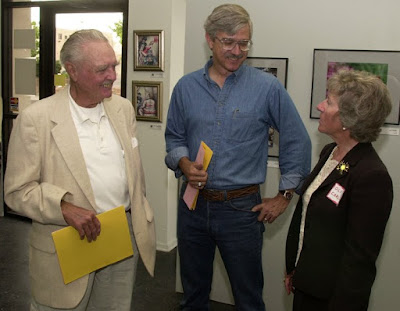 Pennybacker, seen here at the June 1, 2002, opening of the photographic work of then local artist Olivia “OC” Carlisle, right, now of Athens Ga., speaking with my brother, Guy. The three had a common interest in cars and some of Carlisle’s work was of details of racecars. It was the last time I spoke with Pennybacker.
Pennybacker, seen here at the June 1, 2002, opening of the photographic work of then local artist Olivia “OC” Carlisle, right, now of Athens Ga., speaking with my brother, Guy. The three had a common interest in cars and some of Carlisle’s work was of details of racecars. It was the last time I spoke with Pennybacker.
 Pennybacker is seen here, sitting on the right side of a table, during a Jan. 29, 1972, press conference. The briefing was after a police shooting of two men, Antonio Cordova and Rito Canales, who were killed by six officers from the: State Police, Bernalillo County Sheriff’s, and Albuquerque Police Departments, on Black Mesa at an Interstate 25 construction site near South Coors. Officials alleged the men were armed while burglarizing a dynamite storage shed. Officers challenged the men, after breaking the lock, then the men turned on the officers, raising weapons. Officers fired on the men killing them.
Pennybacker is seen here, sitting on the right side of a table, during a Jan. 29, 1972, press conference. The briefing was after a police shooting of two men, Antonio Cordova and Rito Canales, who were killed by six officers from the: State Police, Bernalillo County Sheriff’s, and Albuquerque Police Departments, on Black Mesa at an Interstate 25 construction site near South Coors. Officials alleged the men were armed while burglarizing a dynamite storage shed. Officers challenged the men, after breaking the lock, then the men turned on the officers, raising weapons. Officers fired on the men killing them.
Pennybacker called me “an angry young man” in 1972. I wore the title proudly. When we spoke thirty years later, I told him the only thing that had changed was I was not so young. When Pennybacker quit running around town in “Big Red,” a journalistic art form moved on as well. When I roamed the streets in the late 1960s and early 70’s for photographic opportunities, if I saw “Big Red” moving quickly, I knew to follow, for he was usually on to a story lead. I never got in the way; his story was broadcast within moments and my pictures would not be published for days.
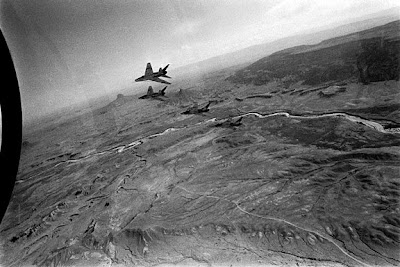 The 188th Tactical Fighter Squadron of the New Mexico Air National Guard had 22 F-100s activated and assigned to Tuy Hoa Air Base, South Vietnam, in June of 1968. Pennybacker and fellow New Mexico journalist, Ernie Mills, went to southeast Asia for a couple of weeks and sent film and audio reports back to KOAT and KGGM TV. I recall it to have been compelling coverage, as they got shots from the back seat of the F-100-D model, of formation flights and individual bombing runs. The same airplanes are seen here in a shot I got from a D model of a four-ship formation over the Rio Puerco, near Cabezon Peak in Sandoval County a few years later. What a ride! But I wasn't being shot at.
The 188th Tactical Fighter Squadron of the New Mexico Air National Guard had 22 F-100s activated and assigned to Tuy Hoa Air Base, South Vietnam, in June of 1968. Pennybacker and fellow New Mexico journalist, Ernie Mills, went to southeast Asia for a couple of weeks and sent film and audio reports back to KOAT and KGGM TV. I recall it to have been compelling coverage, as they got shots from the back seat of the F-100-D model, of formation flights and individual bombing runs. The same airplanes are seen here in a shot I got from a D model of a four-ship formation over the Rio Puerco, near Cabezon Peak in Sandoval County a few years later. What a ride! But I wasn't being shot at.
Pennybacker was an actor in several locally filmed movies. Parts included: playing a teamster in the 1970 production of "The Cheyenne Social Club" with James Stewart, Henry Fonda, Shirley Jones and Sue Ane Langdon.
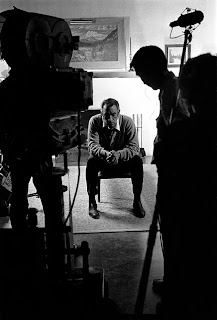 "The City," with Anthony Quinn as the first Hispanic mayor of a southwestern city, that looked an awful lot like Albuquerque, was made in 1971 for ABC TV.
"The City," with Anthony Quinn as the first Hispanic mayor of a southwestern city, that looked an awful lot like Albuquerque, was made in 1971 for ABC TV.
Pennybacker was a glorified ambulance chaser. Don’t get me wrong; he was one of those quintessential newsmen. He could present a story condensed to 20-seconds; a headline and two sentences and you were informed. However, his specialty was fatal automobile accidents.
Pennybacker’s moniker was “Big Red.” He was a barrel-chested man with a stern commentators voice who played a gruff character; serious about his profession. However, when off the air he was also easy going and had a quick smile. At KQEO, he drove an Oldsmobile 442, fully equipped under the hood and loaded with radios and emergency police and fire scanners. It had enough whip antennas mounted on the back of his car to possibly be confused with a tuna trawler. Of course it was red; “Big Red!”
So what’s wrong with this picture?
Some of the old news hounds of the era, who now blog, wrote about Pennybacker. Jim Baca and Joe Monahan share their stories, while former employers, KRQE, and KOAT and the Journal wrote. I also will.
 Pennybacker, seen here at the June 1, 2002, opening of the photographic work of then local artist Olivia “OC” Carlisle, right, now of Athens Ga., speaking with my brother, Guy. The three had a common interest in cars and some of Carlisle’s work was of details of racecars. It was the last time I spoke with Pennybacker.
Pennybacker, seen here at the June 1, 2002, opening of the photographic work of then local artist Olivia “OC” Carlisle, right, now of Athens Ga., speaking with my brother, Guy. The three had a common interest in cars and some of Carlisle’s work was of details of racecars. It was the last time I spoke with Pennybacker. Pennybacker is seen here, sitting on the right side of a table, during a Jan. 29, 1972, press conference. The briefing was after a police shooting of two men, Antonio Cordova and Rito Canales, who were killed by six officers from the: State Police, Bernalillo County Sheriff’s, and Albuquerque Police Departments, on Black Mesa at an Interstate 25 construction site near South Coors. Officials alleged the men were armed while burglarizing a dynamite storage shed. Officers challenged the men, after breaking the lock, then the men turned on the officers, raising weapons. Officers fired on the men killing them.
Pennybacker is seen here, sitting on the right side of a table, during a Jan. 29, 1972, press conference. The briefing was after a police shooting of two men, Antonio Cordova and Rito Canales, who were killed by six officers from the: State Police, Bernalillo County Sheriff’s, and Albuquerque Police Departments, on Black Mesa at an Interstate 25 construction site near South Coors. Officials alleged the men were armed while burglarizing a dynamite storage shed. Officers challenged the men, after breaking the lock, then the men turned on the officers, raising weapons. Officers fired on the men killing them.Pennybacker called me “an angry young man” in 1972. I wore the title proudly. When we spoke thirty years later, I told him the only thing that had changed was I was not so young. When Pennybacker quit running around town in “Big Red,” a journalistic art form moved on as well. When I roamed the streets in the late 1960s and early 70’s for photographic opportunities, if I saw “Big Red” moving quickly, I knew to follow, for he was usually on to a story lead. I never got in the way; his story was broadcast within moments and my pictures would not be published for days.
 The 188th Tactical Fighter Squadron of the New Mexico Air National Guard had 22 F-100s activated and assigned to Tuy Hoa Air Base, South Vietnam, in June of 1968. Pennybacker and fellow New Mexico journalist, Ernie Mills, went to southeast Asia for a couple of weeks and sent film and audio reports back to KOAT and KGGM TV. I recall it to have been compelling coverage, as they got shots from the back seat of the F-100-D model, of formation flights and individual bombing runs. The same airplanes are seen here in a shot I got from a D model of a four-ship formation over the Rio Puerco, near Cabezon Peak in Sandoval County a few years later. What a ride! But I wasn't being shot at.
The 188th Tactical Fighter Squadron of the New Mexico Air National Guard had 22 F-100s activated and assigned to Tuy Hoa Air Base, South Vietnam, in June of 1968. Pennybacker and fellow New Mexico journalist, Ernie Mills, went to southeast Asia for a couple of weeks and sent film and audio reports back to KOAT and KGGM TV. I recall it to have been compelling coverage, as they got shots from the back seat of the F-100-D model, of formation flights and individual bombing runs. The same airplanes are seen here in a shot I got from a D model of a four-ship formation over the Rio Puerco, near Cabezon Peak in Sandoval County a few years later. What a ride! But I wasn't being shot at. Pennybacker was an actor in several locally filmed movies. Parts included: playing a teamster in the 1970 production of "The Cheyenne Social Club" with James Stewart, Henry Fonda, Shirley Jones and Sue Ane Langdon.
 "The City," with Anthony Quinn as the first Hispanic mayor of a southwestern city, that looked an awful lot like Albuquerque, was made in 1971 for ABC TV.
"The City," with Anthony Quinn as the first Hispanic mayor of a southwestern city, that looked an awful lot like Albuquerque, was made in 1971 for ABC TV. Here, Quinn, playing the role of Mayor Thomas Jefferson Alcala, waits a call for action during filming in a Corrales home.
If memory serves me, Pennybacker played a newsman, much like himself. The film was a pilot for the ABC series “The Man and The City,” which ran one season.
Pennybacker had third billing in the 1976 “John Baker's Last Race,” His role was the main character’s father, Jack Baker, in the true story of Manzano High School and UNM cross country and track star turned school teacher at Aspen Elementary School. Baker died of cancer. How he dealt with his impending death inspired a generation of Albuquerque school children. At the insistence of the Aspen students, the School Board renamed the northeast heights school, John Baker Elementary.
Pennybacker appeared in an un-credited role in the 1982, Sean Connery CIA thriller, “Wrong Is Right.”
In 2006, he played Dr. Coffee in a true story “Believe in Me.”
His last movie role was as a train conductor in the soon to be released “Appaloosa.” He continued to write.
Pennybacker lived in the Village of Los Ranchos de Albuquerque where he had been a Trustee. He also was involved with horses and assisted the New Mexico Horse Council and its publication, “The Horsemen's Voice,” which was published by his wife, Sallie Pennybacker, for many years before she retired.
Former KOAT TV news reporter Rodger Beimer remembered one of Pemmybacker’s trademark sign offs, “Reporting live for the grand opening of the Red Lobster at the corner of San Pedro and Montgomery; this is Ed Pennybacker in Big Red.”
Pennybacker had third billing in the 1976 “John Baker's Last Race,” His role was the main character’s father, Jack Baker, in the true story of Manzano High School and UNM cross country and track star turned school teacher at Aspen Elementary School. Baker died of cancer. How he dealt with his impending death inspired a generation of Albuquerque school children. At the insistence of the Aspen students, the School Board renamed the northeast heights school, John Baker Elementary.
Pennybacker appeared in an un-credited role in the 1982, Sean Connery CIA thriller, “Wrong Is Right.”
In 2006, he played Dr. Coffee in a true story “Believe in Me.”
His last movie role was as a train conductor in the soon to be released “Appaloosa.” He continued to write.
Pennybacker lived in the Village of Los Ranchos de Albuquerque where he had been a Trustee. He also was involved with horses and assisted the New Mexico Horse Council and its publication, “The Horsemen's Voice,” which was published by his wife, Sallie Pennybacker, for many years before she retired.
Former KOAT TV news reporter Rodger Beimer remembered one of Pemmybacker’s trademark sign offs, “Reporting live for the grand opening of the Red Lobster at the corner of San Pedro and Montgomery; this is Ed Pennybacker in Big Red.”


